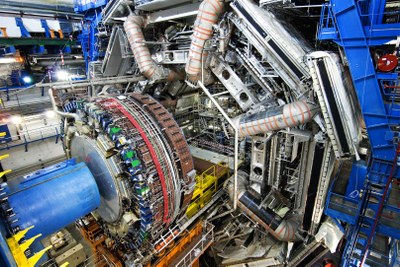The ATLAS Research Program of the HEP Group
The HEP group is part of the international ATLAS collaboration at the Large Hadron Collider (LHC) at CERN.

The primary purpose of the experiments at the Large Hadron Collider at CERN is the discovery of physics beyond our current knowledge and the measurements of the properties of the Standard Model particles, including the newly discovered Higgs boson, at the highest precision to improve our understanding of the nature of our universe.
The photo shows the ATLAS detector as one part of the ATLAS calorimeter is pushed into the experiment.
Our group works on multiple projects within the ATLAS collaboration, which are highlighted below.
Higgs pair production
![PotentialHiggsV_header.png [alternativer Bildtext]](https://www.physik.hu-berlin.de/de/eephys/ag-c-issever/atlas/potentialhiggsv_header-1.png/@@images/image-400-3499c29ea4639c7718894a2fb6e4c8ce.png)
With the discovery of the Higgs boson in 2012, the scientists at the LHC experiments have made a huge step forward in understanding the nature of mass is generated. Yet, the origin of the underlying mechanism is not yet understood. One key element is how strongly the Higgs couples to its self (Higgs self-coupling). We plan to measure that by observing collision events containing pair of Higgs bosons.
Forward physics
![AFPcloseup.jpg [alternativer Bildtext]](https://www.physik.hu-berlin.de/de/eephys/ag-c-issever/atlas/afpcloseup.jpg/@@images/image-400-a188732144dac8716a56ffb2844e7896.jpeg)
When a cosmic particle enters the earth’s atmosphere, it will create a cascade of particles by interacting with the atoms of the atmosphere. In these interactions, only low momenta are transferred (soft interactions), a regime which is difficult to model. Using the forward detectors around ATLAS, we can use the upcoming proton-oxygen collisions to study these types of interactions in a laboratory.
ATLAS performance
![ATLAS_withjets.png [alternativer Bildtext]](https://www.physik.hu-berlin.de/de/eephys/ag-c-issever/atlas/atlas_withjets.png/@@images/image-400-2cf223860818b1b1a6ad59a9538d60d0.png)
In order to analyze ATLAS data to look for Higgs pairs or study forward physics, the performance of the reconstruction algorithms has to be excellent. Our group is working on the reconstruction and energy measurement of jets (showers initiated by quarks and gluons), the tagging of b-quark jets, as well as the tagging and measurements of boosted Higgs jets.
ATLAS trigger
![Computing-header_0.jpg [alternativer Bildtext]](https://www.physik.hu-berlin.de/de/eephys/ag-c-issever/atlas/computing-header_0.jpg/@@images/image-400-75c66c680c9cb8255ba667a5f0e97723.jpeg)
The LHC collides two particle beams 40 million times per second. The amount of data created exceeds what our resources can handle. Using hardware and software algorithms, the ATLAS trigger sorts out which collision events might be interesting, reducing the data volume to “only” about a thousand events per second. Our group contributes to the trigger operation and prepares the trigger for the future LHC program.
New analysis methods
![AI.png [alternativer Bildtext]](https://www.physik.hu-berlin.de/de/eephys/ag-c-issever/atlas/ai.png/@@images/image-400-758fddabbb738a9e5dad53c818f4ded3.png)
By desire, scientists always try to push the boundaries of what is possible to explore the highest knowledge achievable. For us, the incorporation of machine learning and artificial intelligence into our algorithms is key to that goal. The group has already worked on the implementation of the tagging of b-quark and Higgs jets and continues this route in all aspects of our work.
Previous thesis projects
![pO_pi0energyratios.png [alternativer Bildtext]](https://www.physik.hu-berlin.de/de/eephys/ag-c-issever/atlas/po_pi0energyratios.png/@@images/image-400-62a9c1ad1e452392358352049d78a8ac.png)
Previous thesis projects consisted of studies on the phenomenology of Higgs pair events, the study of b-tagging without tracking and preparation for the upcoming forward physics program. The students learn about the complexity of particle collisions at the LHC and how to analyze large datasets of data.
Potential thesis projects
Here you will find a list of potential projects. This list can be extended and further projects can be developed depending on the student's skills and interests. All projects will require some sort of programming. In the time scale of all projects, we have allocated time for you to learn the necessary skills. If you are interested in working with us, please contact Prof. Cigdem Issever (isseverc@hu-berlin.de) and Dr. Hannsjörg Weber (weberhaa@hu-berlin.de). For specific questions on the forward physics and air shower project, you can also contact Dr. Clara Leitgeb (clara.leitgeb@physik.hu-berlin.de).






